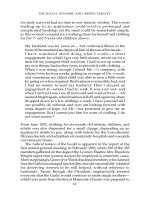ACTRESSES AS WORKING WOMEN 173
Bạn đang xem bản rút gọn của tài liệu. Xem và tải ngay bản đầy đủ của tài liệu tại đây (25.7 KB, 1 trang )
ACTRESSES AS WORKING WOMEN
The truth is, the evil of which he complains had become
unbearable. If we are trying to purify the Haymarket, if the
pose plastique is put down, if the infamous Judge and Jury Club
[e.g. the Coal Hole, a precursor to music halls] is modified, if
the abominations of Holywell-street exist no more, still less
can it be permitted that fashionable vice should mainly usurp
the boxes of the theatres, and indecency and indecorum
shamelessly run riot on the stage.13
None of these enterprises are unique to the West End, but unlike
The Cut in Lambeth, the City Road through Islington, and the
Ratcliffe Highway through Wapping, the entertainments of the West
End were simultaneously perceived and grandly pardoned as
integral parts of the squalor, petty larceny, and sexual markets that
surrounded them. The penny theatres in Whitechapel, in contrast,
were cleared out entirely once the neighbourhood became a focus
for sectarian reformers: there, nothing inimical to middle-class purity,
once detected, was free from missionary interference.14 Clerics in
Knightsbridge also felt their philanthropic work was counteracted
by the greater attractions offered in cheap theatres, and tried to
replicate the East End missionaries’ success.15 But in the West End,
the customary rounds of men’s evenings included a veritably
sacrosanct combination of actresses and, in its most innocent
conclusion, a late supper.
Few, if any, areas of London were free of prostitutes. The West
End’s trade was nominally divided between the theatre district, and
Chelsea and Hanover Square further west (Kings Road, Sloane
Square, and Victoria).16 Daytime prostitution centred on the principal
middle-class shopping streets, but at night the market shifted to
accommodate the main pedestrian and vehicular routes of theatregoers. From 7.00 p.m. when traffic flowed between Mayfair, the City,
and Charing Cross Station until 2.00 a.m. when most pleasure-seekers
had turned homeward, prostitutes were said to keep the Strand
‘literally impassable’.17 Pimped prostitutes strolled Covent Garden,
Duke’s Court (off Drury Lane), Russell Court (off Bow Street), and
all of the Strand from Holywell Street to Trafalgar Square—precisely
following the course of theatres and two-a-night music halls.
Haymarket prostitutes were more specialized, engaging in their trade
between 11.00 p.m. and 1.00 a.m.; in other words, between the closing
of Her Majesty’s, the Comedy, Pavilion, and Haymarket Theatres
and the opening of Evans’s, Dubourg’s, the Hotel de Paris, the Cafe
144









